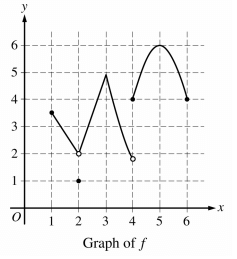WORKSHEET ON APPLICATIONS OF DERIVATIVES FOR AP CALCULUS
Subscribe to our ▶️ YouTube channel 🔴 for the latest videos, updates, and tips.
Problem 1 :
If y = x sin x, then dy/dx
A) sin x + cos x B) sin x + x cos x C) sin x - x cos x
D) x(sin x + cos x) E) x(sin x - cos x)
Problem 2 :
Let f be the function given by f(x) = 300x - x3. On which intervals is the function f increasing ?
A) (-∞, -10] and [10, ∞) B) [-10, 10] C) [0, 10] only
D) [0, 10√3] only E) [0, ∞)
Problem 3 :
If f(x) = 7x - 3 + ln x, then f'(1) = ?
A) 4 B) 5 C) 6 D) 7 E) 8
Problem 4 :

Problem 5 :
If y = (x3 - cos x)5, then find y'
A) 5(x3 - cos x)4 B) 5(3x2 + sin x )4
C) 5(3x2 + sin x) D) 5(3x2 + sin x)4 (6x + cos x)
E) 5(x3 - cos x)4 (3x2 + sin x)
Problem 6 :
If
f(x) = √(x2-4) and g(x) = 3x-2
then find the derivative of f((g(x)) at x = 3
A) 7/√5 B) 14/√5 C) 18/√5 D) 15/√21 E) 30/√21
Problem 7 :
The function f is defined by f(x) = x/(x + 2). What points (x, y) on the graph of f have the property that the line tangent to f at (x, y) has slope 1/2 ?
A) (0, 0) only B) (1/2, 1/5) only C) (0, 0) and (-4, 2)
D) (0, 0) and (4, 2/3) E) There are no such points
Problem 8 :
Let f(x) = (2x+1)3 and let g be the inverse function of f. Given that f(0) = 1, what is the value of g'(1) ?
A) -2/27 B) 1/54 C) 1/27 D) 1/6 E) 6
Problem 9 :
Let f be the function defined by f(x) = ln x/x. What is absolute maximum value of f ?
A) 1 B) 1/e C) 0 D) -e
E) f does not have an absolute maximum value
Problem 10 :
Let g be the function given by g(x) = x2 ekx, where k is a constant. For what value of k does g have critical point at x = 2/3 ?
A) -3 B) -3/2 C) -1/3 D) 0 E) There is no such k.
Answer Key
1) dy/dx = x cos x + sin x
2) At (-10, 10), the function f(x) is having positive slope. So, option B is correct.
3) 8
4) Option C
5) y' = 5(x3 - cos x)4 (3x2 + sin x)
6) 7/√5
7) (0, 0) and (-4, 2).
8) g(1) = 1/6
9) f(e) = 1/e
10) k = -3
Subscribe to our ▶️ YouTube channel 🔴 for the latest videos, updates, and tips.
Recent Articles
-
Finding Range of Values Inequality Problems
May 21, 24 08:51 PM
Finding Range of Values Inequality Problems -
Solving Two Step Inequality Word Problems
May 21, 24 08:51 AM
Solving Two Step Inequality Word Problems -
Exponential Function Context and Data Modeling
May 20, 24 10:45 PM
Exponential Function Context and Data Modeling